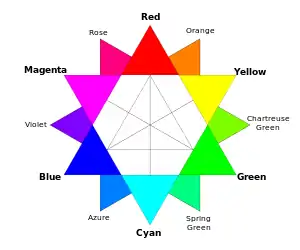Monochrome
A monochromic[1] image is composed of one color (or values of one color).[2] The term monochrome comes from the Ancient Greek: μονόχρωμος, romanized: monochromos, lit. 'having one color'.



A monochromatic object or image reflects colors in shades of limited colors or hues. Images using only shades of grey (with or without black or white) are called grayscale or black-and-white. However, scientifically speaking, monochromatic light refers to visible light of a narrow band of wavelengths (see spectral color).
Application
Of an image, the term monochrome is usually taken to mean the same as black and white or, more likely, grayscale, but may also be used to refer to other combinations containing only tones of a single color, such as green-and-white or green-and-red. It may also refer to sepia displaying tones from light tan to dark brown or cyanotype ("blueprint") images, and early photographic methods such as daguerreotypes, ambrotypes, and tintypes, each of which may be used to produce a monochromatic image.
In computing, monochrome has two meanings:
- it may mean having only one color which is either on or off (also known as a binary image),
- allowing shades of that color.
A monochrome computer display is able to display only a single color, often green, amber, red or white, and often also shades of that color.
In film photography, monochrome is typically the use of black-and-white film. Originally, all photography was done in monochrome. Although color photography was possible even in the late 19th century, easily used color films, such as Kodachrome, were not available until the mid-1930s.
In digital photography, monochrome is the capture of only shades of black by the sensor, or by post-processing a color image to present only the perceived brightness by combining the values of multiple channels (usually red, blue, and green). The weighting of individual channels may be selected to achieve a desired artistic effect; if only the red channel is selected by the weighting then the effect will be similar to that of using a red filter on panchromatic film. If the red channel is eliminated and the green and blue combined then the effect will be similar to that of orthochromatic film or the use of a cyan filter on panchromatic film. The selection of weighting thus allows a wide range of artistic expression in the final monochromatic image.
For production of an anaglyph image the original color stereogram source may first be reduced to monochrome in order to simplify the rendering of the image. This is sometimes required in cases where a color image would render in a confusing manner given the colors and patterns present in the source image and the selection filters used (typically red and its complement, cyan).[3]
In physics
In physics, monochromatic light is electromagnetic radiation of a single frequency. In the context of physics, no source of electromagnetic radiation is purely monochromatic, since that would require a wave of infinite duration as a consequence of the Fourier transform's localization property (cf. spectral coherence). Even very controlled sources such as lasers operate in a range of frequencies (known as the spectral linewidth). In practice, filtered light, diffraction grating separated light and laser light are all routinely referred to as monochromatic. Often light sources can be compared and one be labeled as “more monochromatic” (in a similar usage as monodispersity). A device which isolates a narrow band of frequencies from a broader-bandwidth source is called a monochromator, even though the bandwidth is often explicitly specified, and thus a collection of frequencies is understood.
See also
| Look up monochrome in Wiktionary, the free dictionary. |
- Duotone – the use of two ink colors in printing
- Halftone – the use of black and white in a pattern that is perceived as shades of grey (may be extended also to color images)
- Polychrome – of multiple colors, the opposite of monochrome
- Monochromacy (color blindness)
- Monochromatic color
- Selective color – use of monochrome and color selectively within an image
- Monochrome painting – monochromes in art
References
- From the Ancient Greek: μονόχρωμος – monochromos “having one color”.
- "monochrome", Merriam-Webster Online Dictionary, 2009, retrieved October 16, 2009
- "Monochromatic". Dictionary.com Unabridged. Random House, Inc. Retrieved March 23, 2013.

